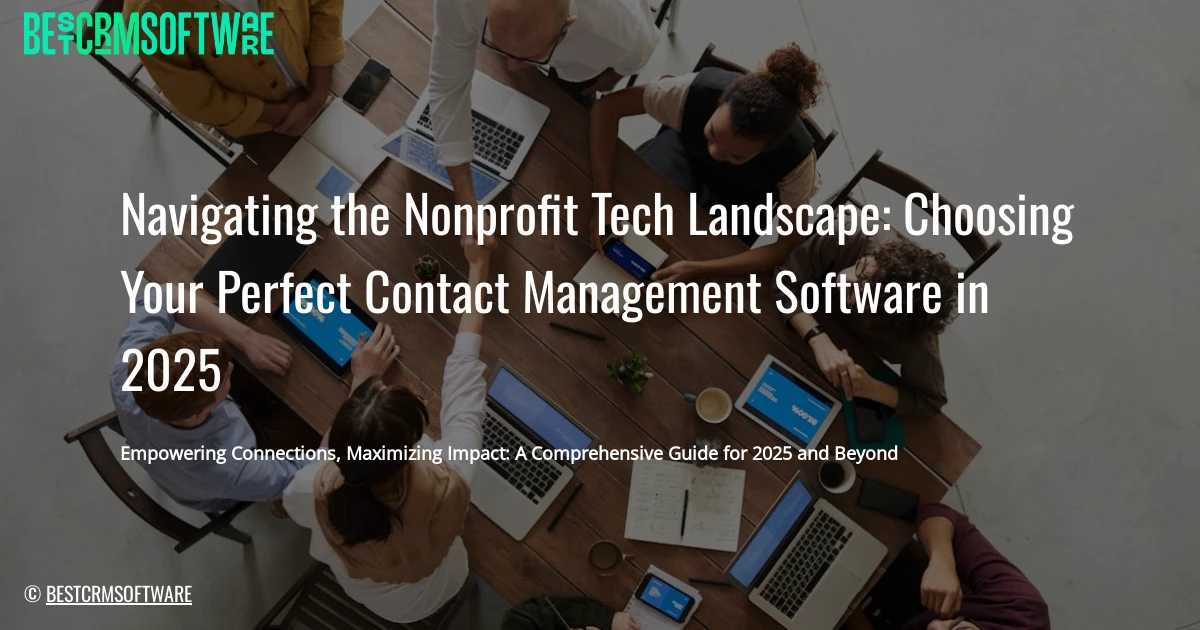Empowering Connections, Maximizing Impact: A Comprehensive Guide for 2025 and Beyond
Laying the Groundwork: Pre-Selection Essentials
Before diving into the sea of contact management software options, it’s crucial to establish a clear foundation. This involves understanding your organization’s unique needs and prioritizing the features that will truly propel your mission forward.
Here’s a breakdown of essential pre-selection considerations:
1. Define Your Organization’s Needs and Goals:
- What are your primary objectives for using contact management software? Are you aiming to streamline communication, manage donor relationships, track program impact, or all of the above?
- What specific challenges are you hoping to address with the new software? Are you struggling with data silos, inefficient processes, or a lack of centralized information?
- Consider your organizational size and complexity. Do you have a small team with limited needs or a large organization with diverse departments and workflows?
2. Determine Essential Features:
- Contact Database: What information needs to be captured about your contacts (individuals, businesses, or organizations)? Does it need to be detailed, encompassing demographics, interests, and donation history?
- Communication Tools: Do you require integrated email, SMS, or social media marketing features?
- Donor Management: If you manage fundraising, you’ll need robust tools for tracking donations, creating appeals, and managing pledge fulfillment.
- Reporting & Analytics: Do you need to generate insightful reports on engagement levels, donor trends, or program outcomes?
- Additional features: Consider integration with your current systems (accounting software, CRM, etc.), automation capabilities, security protocols, and data export options.
3. Consider Your Budget Constraints and Explore Pricing Models:
- Establish your budget range and prioritize features within that range.
- Research pricing models: Subscription-based, pay-per-feature, or flat-fee?
- Evaluate hidden costs: implementation services, training, data migration fees.
4. Assess Your Technology Infrastructure and Compatibility Needs:
- What operating system and device compatibility are needed? Cloud-based software offers flexibility but ensure it’s secure and integrates well with your systems.
- Is your existing infrastructure compatible with the new software? Can you easily transfer data, ensure proper access, and ensure data security?
5. Evaluate Existing Software Solutions Used by Your Nonprofit:
- Identify opportunities for seamless integration: Can the contact management software you choose connect with your CRM, accounting software, or other vital applications?
- Explore potential data migration strategies: Will the software support importing data from existing platforms or will you need a manual process?
By thoroughly addressing these pre-selection essentials, you’ll ensure that the contact management software you ultimately choose aligns perfectly with your needs, goals, and overall strategy, positioning you for long-term success in navigating the evolving nonprofit tech landscape.
Contact Management Reimagined: Powering Engagement
The right contact management software can transform your nonprofit’s outreach and engagement efforts, turning a mass of names into a powerful engine for personalized impact. In 2025, expect solutions that prioritize data-driven engagement and offer features designed to elevate your connection with each individual supporter.
Here are key features to look for:
- Segmentation for targeted campaigns: Don’t just blast out messages to the masses. Segment your contacts based on demographics, donor history, and engagement levels to personalize campaigns and maximize their effectiveness. For instance, target a specific group of young professionals with a volunteer opportunity, while reaching out to major donors with exclusive updates.
- Customizable data fields for detailed constituent profiles: Build truly comprehensive profiles for each supporter, capturing not just contact information, but also crucial insights like their areas of interest, preferred communication channels, and engagement history. These customized fields allow for deeper understanding and more impactful interactions.
- Bulk import and export capabilities for seamless data management: Say goodbye to clunky spreadsheets and manual data entry. Look for software that enables effortless import and export, allowing you to seamlessly integrate data from existing systems or export reports for in-depth analysis.
- Relationship tracking: Interactions, donations, volunteer history: Beyond basic contact information, track the entire history of your interactions, including donations, volunteer activities, and even communication details. This holistic view enables a truly relationship-based approach and empowers you to personalize communication and recognize each supporter’s unique contribution.
- Privacy and data security compliance: GDPR, CCPA: In 2025, data privacy is paramount. Ensure your software adheres to the latest regulations like GDPR and CCPA, providing strong data encryption, access control, and comprehensive compliance tools.
By choosing software with these key features, you can move beyond basic contact management and unlock a new era of engagement, fostering deeper connections with your supporters and achieving your mission’s full potential.

© Andrea Piacquadio
Beyond the Database: Amplifying Communication & Outreach
Contact management software is no longer just about storing information. In 2025, it’s a powerhouse for amplifying your nonprofit’s communication and outreach efforts. Beyond the basic database functionalities, look for software that integrates robust communication tools, empowering you to engage your audience like never before:
1. Email Marketing Automation: This isn’t your grandpa’s newsletter. The best contact management platforms offer advanced email automation capabilities:
- Drip Campaigns: Create automated sequences of emails triggered by specific actions or milestones, nurturing your donor relationships and increasing engagement.
- Event Reminders: Ensure high attendance rates by automating timely event reminders and registration confirmations.
- Personalized Appeals: Target your messaging by segmenting your audience based on interests, giving history, and donation levels. Tailored appeals drive greater impact.
2. Social Media Integration: Your nonprofit lives on social media too! The right software seamlessly integrates with your favorite platforms, allowing you to:
- Schedule Posts: Plan content in advance and maintain a consistent online presence without constant manual updates.
- Track Engagement: Analyze social media data to understand audience behavior, identify successful campaigns, and optimize future strategies.
- Manage Interactions: Respond quickly and efficiently to comments and messages, fostering stronger relationships with your followers.
3. SMS/Text Messaging Capabilities: For urgent updates or time-sensitive appeals, text messaging provides a direct and immediate channel:
- Event Alerts: Notify donors and supporters about upcoming events, cancellations, or last-minute opportunities.
- Donation Appeals: Launch targeted text-based campaigns to reach supporters quickly and efficiently, driving higher engagement and conversion rates.
- Timely Updates: Share project updates, success stories, and inspiring testimonials through brief and impactful text messages.
4. Two-way Communication Channels: Beyond broadcasting messages, true engagement requires dialogue. Top-tier platforms offer:
- Surveys: Gauge supporter satisfaction, understand donor needs, and gather valuable feedback to guide future programs and initiatives.
- Feedback Forms: Collect input from stakeholders and ensure transparency in your decision-making process.
- Constituent Support: Offer integrated communication channels for individuals to request information, ask questions, and report issues.
By embracing these advanced communication tools, you can turn your contact management software into a dynamic platform for building stronger relationships, amplifying your voice, and achieving your mission.
Fundraising Amplified: Cultivating Donor Relationships
Your contact management software isn’t just a tool to store data; it’s a strategic ally in building meaningful relationships with your donors. To cultivate a vibrant giving community, you need software that goes beyond basic contact details and actively empowers you to maximize fundraising potential. Here’s how the right technology can streamline your donor engagement and propel your fundraising efforts:
Online Donation Platforms Integration: Seamlessly connect your contact management software with leading online donation platforms. This ensures secure processing, allowing donors to contribute conveniently with single clicks. Implement recurring gift functionality to foster consistent support and establish a steady revenue stream. Finally, empower donors with access to their personal donation history and information through secure portals, offering transparency and building trust.
Gift Tracking & Acknowledgement: Customizable receipt templates provide detailed records of every donation, enabling accurate record keeping and IRS compliance. Automate thank-you messages, adding a personal touch and reinforcing the impact of every contribution. Comprehensive donor reporting provides insights into giving patterns, donor demographics, and engagement trends, informing future fundraising strategies.
Pledge Management: Effectively track pledge installments, setting automatic reminders to ensure timely payments and keep your funding pipeline flowing. Generate detailed pledge fulfillment reports for transparency and accountability, maintaining a strong rapport with your pledgers.
Grant Management Functionalities: Streamline your grant seeking process with robust grant management functionalities. Organize applications, set up deadline alerts, and efficiently track the status of funding proposals. Generate insightful reports on funding sources, enabling you to analyze grant trends and strategically pursue new opportunities.
Investing in contact management software that fosters deep donor engagement and amplifies your fundraising capacity is crucial. By integrating these features, you empower your organization to build a lasting foundation for financial sustainability and strengthen the connections with your invaluable supporters.

© Alexander Suhorucov
Unlocking Data’s Potential: Measuring Your Nonprofit’s Impact
Choosing the right contact management software for your nonprofit isn’t just about storing contacts – it’s about empowering your organization with data-driven insights to achieve meaningful impact. With the right software, you can move beyond simply managing your donor base and unlock the true potential of data for your mission.
Modern contact management solutions offer powerful features to track and measure your nonprofit’s success, giving you a comprehensive understanding of your program’s effectiveness and its impact on beneficiaries:
- Impact Measurement Dashboards: Imagine visualizing the tangible results of your programs in real-time. Impact measurement dashboards transform data into insightful, visual representations, clearly showcasing the difference your organization makes. This data empowers you to demonstrate the value of your work to donors and potential supporters, building trust and increasing funding opportunities.
- Customizable Reports: Gain deep insights into campaign performance, donor behavior, and program trends with flexible, customizable reports. Analyze donor demographics, engagement patterns, and donation history to identify key audiences, tailor outreach efforts, and refine your fundraising strategies.
- Data Visualization Tools: Communicate your impact effectively through compelling data visualizations. Create visually appealing reports, presentations, and impactful stories using interactive charts, graphs, and dashboards, allowing you to connect with stakeholders on a deeper emotional level and demonstrate the tangible results of your work.
- Integration with Data Analysis Software: Dive deeper into your data with seamless integrations to powerful data analysis software. Analyze complex trends, identify correlations, and extract actionable insights that can optimize your program implementation, drive strategic decision-making, and enhance your overall impact.
By leveraging these advanced data features, your nonprofit can shift from managing contacts to driving positive change. Choosing contact management software with a focus on data-driven impact allows you to unlock the full potential of your data, empowering your organization to achieve sustainable success and make a real difference in the world.
Navigating User Experience: From Clunky to User-Friendly
In the world of nonprofits, time is a precious commodity. The ability to manage your contact database seamlessly and efficiently is essential, not just for individual productivity, but for maximizing the impact of your entire team. Your contact management software should be more than just a data storage solution – it needs to be intuitive, accessible, and adaptable to your diverse needs. Here’s a look at how to choose software that ensures user-friendliness for your team:
1. Intuitive User Interface and User Experience for Team-Wide Adoption:
Your software should be designed with a focus on simplicity and ease of use. A clear, uncluttered interface that mirrors natural workflows will make onboarding easier and promote team-wide adoption. Features should be readily available, and users shouldn’t need extensive training to navigate the platform. Consider user-friendly tools like drag-and-drop functionality for list creation or pre-populated templates for efficient communication.
2. Accessibility Features for Diverse Users: Screen Readers, Keyboard Navigation, Multi-Language Support:
Inclusivity should be at the heart of your technology choices. Your contact management software should cater to diverse user needs and abilities. This includes supporting screen readers for visually impaired users, ensuring smooth keyboard navigation for those who prefer it, and providing multi-language support to accommodate staff and stakeholders from varied backgrounds.
3. Mobile-Friendly Interface for On-the-Go Access:
Today’s busy professionals need flexibility and access to information anytime, anywhere. Your contact management software should offer a responsive, mobile-friendly interface. This allows staff to update contact information, manage tasks, and communicate with donors or volunteers seamlessly from their mobile devices, keeping operations agile and responsive.
4. Role-Based Permissions: Control Data Access Based on Staff Responsibilities:
To safeguard sensitive information and ensure smooth collaboration, role-based permissions are crucial. Your contact management software should allow you to restrict access to specific data and features based on user roles within your organization. This ensures that only authorized personnel have access to confidential information, protecting your donors’ data and streamlining internal operations.
Investing in contact management software that prioritizes a positive user experience not only improves efficiency and productivity but also fosters team engagement and builds a more inclusive, accessible environment for your organization.

© Christina Morillo
Building for the Future: Scalability & Integrations
Nonprofits are constantly evolving, with ever-changing programs, staff, and supporter bases. As your organization grows, so too do your data needs and reliance on technology. Choosing a contact management software that can handle this growth is crucial for future success. This is where the focus shifts to scalability, flexibility, and integration capabilities.
Here’s how a robust contact management platform can lay the foundation for your nonprofit’s future:
Scalability and flexibility to accommodate organizational growth: Imagine a system that effortlessly handles a growing number of contacts, donor segments, and intricate program details. The ideal solution will have the capacity to adapt to your expanding needs without encountering performance issues. This flexibility ensures your data stays organized and accessible, even as your organization blossoms.
Open API and integration options for connecting with other software solutions: Today’s nonprofit operates within a diverse technological landscape. Your chosen contact management software should be able to seamlessly integrate with other crucial systems you use, like fundraising platforms, email marketing tools, and even your website. Open API’s ensure data flow freely between platforms, fostering greater efficiency and insightful data analysis.
Data migration support from your existing system to the new software: Switching systems shouldn’t be a daunting task. Look for platforms that provide seamless data migration support from your previous system to their own. This minimizes disruptions to your daily workflow and guarantees a smooth transition to your new contact management solution.
Cloud-based solutions for remote access, collaboration, and data security: In an increasingly remote work environment, cloud-based solutions are paramount. This allows staff members to access critical contact information anytime, anywhere, enhancing collaboration and improving productivity. Cloud-based solutions also prioritize robust data security protocols, keeping your valuable information safe from threats and ensuring compliance with industry regulations.
By selecting a contact management software with a robust foundation in these areas, nonprofits can future-proof their operations and position themselves for continued success. This isn’t just about managing data; it’s about creating a dynamic ecosystem where technology empowers your mission and fuels sustainable growth.
Investing Wisely: Understanding the Financial Landscape
Choosing the right contact management software is not just about picking the shiniest interface. It’s about making a smart investment that aligns with your nonprofit’s budget and long-term needs. Navigating the diverse financial landscape is essential, and it’s important to weigh the pros and cons of each model before committing.
1. Evaluating Free and Open-Source Software Options:
Free and open-source options present a tempting starting point, especially for resource-strapped nonprofits. Here’s what to consider:
- Features: Free and open-source software can offer basic functionalities, including contact management, email marketing, and task tracking. However, they may lack the advanced features of paid solutions, such as automation, reporting, or integrations with other essential platforms.
- Limitations: The “free” tag often comes with tradeoffs. These may include limited storage, user accounts, and functionality. You might encounter a cap on certain actions or have access only to a barebones version of the software.
- Community Support: The strength of the community behind open-source software is vital. You need to research its level of support through forums, documentation, and dedicated resources to ensure help when you encounter technical challenges.
2. Paid Subscription Models:
Paid subscription models offer a wider range of features and benefits but require a consistent budget allocation. Here’s what to dissect:
- Pricing Tiers: Most subscription-based solutions have tiered pricing, with higher tiers offering more features, users, storage, and support. Evaluate the pricing structure to see which tier best aligns with your needs and budget.
- Feature Variations: Examine what features are included at each tier. Determine which are essential to your organization’s operation and choose the tier that provides adequate functionality without unnecessary bells and whistles.
- Contract Terms: Carefully read the contract terms to understand renewal fees, cancellation policies, and any commitment periods. Be sure to understand how the pricing model works (monthly, yearly, etc.) and consider long-term cost implications.
3. One-Time Purchase Options:
Some contact management software can be purchased with a one-time upfront cost. This can seem enticing, but it’s crucial to examine the full picture:
- Potential for Long-Term Cost Savings: The upfront cost can potentially save your nonprofit money over time, especially if your needs remain relatively stable.
- Assess Ongoing Support Fees: While the software itself might be bought outright, remember that ongoing support, such as technical help, software updates, and upgrades, often involve additional recurring fees.
4. Factor in Costs Beyond the Software:
Don’t forget to account for these expenses in your budgeting process:
- Implementation Costs: Integrating the chosen software into your organization can involve significant setup time, customization, data migration, and potential expert support.
- Training: Familiarizing your staff with the software is essential for adoption and effective use. You may need to invest in dedicated training sessions or self-paced learning resources.
- Ongoing Maintenance: Regularly maintaining the software, ensuring security updates, and troubleshooting issues requires time and resources, either in-house or outsourced to a professional provider.
By carefully considering all financial aspects, your nonprofit can choose contact management software that best suits its financial limitations and provides long-term value.

© Andrea Piacquadio
Vetting Potential Vendors: From Trust to Transparency
Choosing the right contact management software (CMS) is crucial for your nonprofit’s success. But with so many options available, how do you navigate the landscape and find the perfect fit?
The key is a thorough vetting process that goes beyond just comparing features. This involves building trust through research and evaluating vendor transparency. Here’s a breakdown of how to achieve this:
1. Identifying Reputable Vendors with Proven Track Records in the Nonprofit Sector:
- Focus on experience: Look for vendors who specifically specialize in serving nonprofits. They’ll understand the unique needs and challenges of your organization.
- Seek out certifications and awards: Certifications like Salesforce’s Nonprofit Cloud accreditation demonstrate a vendor’s commitment to serving the nonprofit community. Awards and recognitions for customer satisfaction and innovation are also strong indicators of a reputable vendor.
2. Reading User Reviews and Testimonials from Similar Organizations:
- Go beyond vendor websites: Explore trusted review sites like G2, Capterra, and TrustRadius. Read reviews from other nonprofits, paying close attention to their specific experiences with the software.
- Look for specific mentions of your nonprofit’s key needs: Are they mentioning strong donor management capabilities? Integration with fundraising platforms? User-friendliness for volunteer engagement?
3. Checking Vendor’s Customer Support Resources: FAQs, Knowledge Bases, Online Communities:
- Transparent support is key: A vendor who readily shares information about their support resources is likely to be reliable in the long run.
- Dive into their FAQs: Do they cover common issues you might encounter?
- Explore their knowledge bases: Are there helpful articles and tutorials that can assist you with basic questions?
- Check out online communities: Are there active user forums where you can connect with other users and learn from their experiences?
4. Seeking Recommendations from Other Nonprofits Within Your Network:
- Leverage your connections: Ask your peers and colleagues about their experiences with different CMS providers. Their firsthand recommendations can provide valuable insights.
- Join nonprofit technology communities: These communities often feature discussions about various CMS tools, allowing you to learn from the experiences of others.
Remember, the best contact management software for your organization will not only provide the features you need but also offer strong customer support, a commitment to nonprofit sector values, and a transparent approach to service delivery. This vetting process ensures that your chosen solution empowers you to effectively manage your donor relationships, streamline operations, and drive impactful change within your community.
From Theory to Practice: Hands-on Software Evaluation
Once you’ve narrowed down your potential contact management software options, it’s time to get hands-on. This stage involves transitioning from theoretical comparisons to a practical evaluation process. Here’s how you can ensure you’re making an informed choice:
Requesting demos and free trials: Don’t just rely on marketing materials. Schedule demos to witness the software in action and explore its functionalities firsthand. Free trials, often available for a limited period, allow you to experience the platform in your own environment, working with your own data and team.
Engaging with sales representatives and understanding their support model: This is your opportunity to directly understand the vendor’s approach to customer support. Ask detailed questions about response times, availability of resources, and training opportunities. A strong support system is essential for seamless integration and ongoing use.
Involving key stakeholders in the evaluation process: This is not a solo mission. Include representatives from your fundraising, communications, volunteer, and program teams in the evaluation process. Their diverse perspectives will provide valuable insights on the software’s usability, data integration, and overall fit within your organization’s workflows.
Testing the software with realistic scenarios: Simulate real-life situations within your nonprofit using the trial software. Import relevant data, create new contacts, segment your audience, send personalized messages, and track interactions. This real-world application will reveal the platform’s strengths and weaknesses within the context of your unique organizational needs.
By actively engaging with the chosen software and involving key stakeholders throughout the process, your nonprofit will be better positioned to choose the contact management platform that truly meets your current and future requirements.

© Alexander Suhorucov
Implementing Your Chosen Solution: Setting Up for Success
The journey to finding the perfect contact management software is just the first step. Making the most of your chosen platform requires a smooth and efficient implementation process. Here are key steps to ensure a seamless transition and maximum impact:
1. Ensuring a Smooth Transition from Your Existing System:
- Data Migration Planning: This is crucial for minimizing disruptions. Assess the complexity of migrating data, understand the vendor’s migration tools and services, and develop a detailed data migration plan. Schedule the transition strategically, accounting for peak periods and staff availability.
- Minimizing Disruptions: Prepare your staff and donors by providing clear communication about the changes. This could include explaining the new platform’s features, training sessions, and potential temporary outages during the migration process.
2. Providing Adequate Training for Staff:
- Utilizing Vendor Resources: Leverage the vendor’s training materials, online tutorials, and dedicated support personnel to equip your staff with the skills to effectively use the new system.
- Developing Internal Expertise: Assign internal “champions” to learn the software in depth and become trusted resources for their colleagues. These individuals can lead training sessions, troubleshoot problems, and promote ongoing learning within the organization.
3. Establishing Clear Communication Channels with the Vendor During and After Implementation:
- Regular Check-ins: Set up consistent communication channels with your vendor for addressing implementation challenges, reporting issues, and requesting support. This helps maintain a proactive and collaborative approach throughout the process.
- Feedback Loops: Establish clear processes for gathering feedback from your staff on the implementation process and the software itself. Share this feedback with the vendor to refine their solutions and enhance their future offerings.
4. Creating Internal Documentation and Resources to Support Ongoing Software Usage:
- Knowledge Base: Build a comprehensive knowledge base or FAQ section within your internal resources to capture common questions and troubleshooting steps. This empowers staff to find answers independently.
- Training Materials: Develop internal training materials and presentations that complement the vendor’s resources. Tailor these materials to your organization’s specific processes and workflows to optimize their effectiveness.
By taking these proactive steps, your nonprofit can overcome the common challenges of software implementation and unlock the full potential of your new contact management platform. A well-planned and executed implementation ensures your team is comfortable and empowered to leverage this tool for increased efficiency and greater impact.
Beyond Implementation: Optimizing and Adapting Your Approach
Choosing the right contact management software is just the first step. As your nonprofit evolves, staying ahead of the curve and maximizing the software’s potential becomes paramount. This requires a proactive approach that goes beyond simply implementing the tool. Here’s how you can optimize and adapt your approach in the ever-changing tech landscape:
- Staying abreast of emerging trends in nonprofit technology: The world of nonprofit technology is constantly evolving, with advancements like AI, automation, and predictive analytics shaping the landscape. Actively exploring these emerging technologies helps you identify opportunities to streamline operations, enhance data-driven decision making, and further personalize donor engagement.
- Regularly evaluating your chosen software’s effectiveness: Don’t settle for a “set-it-and-forget-it” mentality. Continuously monitor how the software performs in terms of user satisfaction, operational efficiency, and impact on key performance indicators. Regular data analysis will uncover potential areas for improvement and reveal whether the chosen software continues to be the best fit for your organization’s needs.
- Seeking feedback from staff and stakeholders to identify areas for improvement: Feedback is invaluable in navigating this evolving landscape. Encourage open communication and solicit insights from staff members, donors, and other stakeholders about their experiences with the software. This firsthand perspective will unveil any limitations, challenges, or areas for enhancement that might be overlooked otherwise.
- Remaining flexible and adapting your software strategy as your organization evolves: The needs of your organization will inevitably change over time. Perhaps new initiatives arise, new data points need to be captured, or you require integrations with other platforms. Be prepared to adapt your software strategy to meet these emerging demands. This might entail adding new modules, migrating to a different system entirely, or customizing existing functionality. Flexibility and a willingness to adjust your approach will ensure the software remains a powerful tool for your nonprofit’s continued success.
By prioritizing continuous evaluation, embracing technological advancements, and fostering open communication, your nonprofit can transform its chosen software from a static resource into a dynamic tool that fuels its mission and paves the way for future growth.

© Helena Lopes
Spotlight on Leading Solutions: Exploring Popular Options
Choosing the right contact management software is crucial for any nonprofit, as it forms the foundation of your donor relationships and fundraising efforts. With so many options available, it’s easy to feel overwhelmed. To guide you through the decision process, we’ve compiled a list of popular solutions, each catering to distinct needs and preferences:
- DonorPerfect: This solution is a robust choice for organizations focused on extensive fundraising capabilities. It boasts advanced donor management features, allowing you to track donations, build complex reports, and analyze giving patterns in depth.
- Bloomerang: Prioritizing donor retention and engagement, Bloomerang stands out with its innovative features to nurture long-term relationships. From automated thank-you messages to personalized communications, this platform helps you build meaningful connections with your supporters.
- Salesforce Nonprofit Success Pack: If you seek high customizability and a wide array of integrations, this platform offers a powerful solution. It allows you to build bespoke workflows, connect with other applications, and access a vast ecosystem of resources for nonprofits.
- Network for Good: This software excels in its user-friendly interface and robust fundraising tools. Ideal for smaller nonprofits and organizations seeking intuitive design, it offers seamless donation processing, streamlined communication channels, and strong online fundraising capabilities.
- NeonCRM: Focused on cloud-based functionality, especially for growing nonprofits, NeonCRM provides scalability and adaptability. This platform boasts automation features, a flexible system to manage multiple campaigns, and tools to support a dynamic growth strategy.
This list serves as a starting point for your exploration. Remember to carefully assess your specific organizational needs, fundraising goals, and budget limitations when making your final choice.
Navigating Data Privacy: Protecting What Matters Most
Nonprofits are entrusted with sensitive information – donor details, volunteer records, program participant data, and more. Choosing the right contact management software isn’t just about efficiency; it’s about safeguarding this vital information.
Here’s what you need to consider in 2025:
Protecting sensitive data with robust security measures:
- Encryption: All data at rest and in transit should be encrypted.
- Access controls: Implement granular access controls, allowing only authorized individuals to access specific data sets.
- Regular backups: Regularly back up your data to multiple locations, ensuring redundancy and disaster recovery capabilities.
Ensuring compliance with data privacy regulations:
- GDPR (General Data Protection Regulation) and CCPA (California Consumer Privacy Act): These and other evolving regulations demand strict adherence to data protection protocols.
- Donor privacy policies: Ensure your software aligns with your organization’s specific donor privacy policies, providing transparency and control over data usage.
Educating staff on best practices for data security and privacy:
- Training: Conduct regular training sessions to educate staff on proper data handling procedures, password security, and recognizing phishing attempts.
- Awareness: Foster a culture of data privacy within your organization, ensuring everyone understands their responsibilities.
Developing internal policies for data management, storage, and access:
- Clear guidelines: Implement policies for data collection, use, and retention, covering procedures for consent, data deletion, and incident response.
- Data governance: Designate a data steward or committee responsible for overseeing data privacy practices and ensuring compliance.
Remember, data privacy isn’t just about compliance; it’s about earning and maintaining the trust of your stakeholders. By implementing these measures, you can confidently navigate the complex landscape of data privacy and build a robust security framework for your nonprofit in 2025.

© Emmy E
Expanding Your Tech Ecosystem: Integrating for Greater Impact
In the ever-evolving nonprofit landscape, maximizing efficiency and impact requires a holistic approach to technology. The days of stand-alone solutions are over; today, seamless integration is key to unlocking the full potential of your contact management software. This section explores four crucial aspects of integration that can elevate your nonprofit’s technological capabilities:
1. Integrating with your Website for Seamless Engagement:
Your website is the digital storefront for your organization, a crucial platform for capturing leads, processing donations, and managing events. By integrating your contact management software with your website, you create a frictionless experience for supporters:
- Lead Capture: Capture website visitor data, sign them up for email lists, and automatically populate your contact database with their information.
- Donation Processing: Simplify the donation process with secure payment gateways, streamline recurring donations, and track donation history effortlessly.
- Event Management: Promote events on your website, facilitate ticket sales and registrations directly through your contact management platform, and manage event details seamlessly.
2. Connecting with Social Media for Enhanced Engagement:
Social media has become an essential channel for nonprofits to connect with supporters, foster community, and amplify their message. Integrating your contact management software with social media platforms opens up exciting possibilities:
- Expanded Reach: Utilize social media ads to target new audiences and automatically add those who express interest to your database.
- Engagement Analytics: Track social media interactions, understand what content resonates with your supporters, and adjust your outreach strategy accordingly.
- Donor Cultivation: Create personalized social media messages for specific supporter segments based on their engagement and donation history.
3. Embracing Mobile Technology for On-the-Go Power:
Modern nonprofits are increasingly mobile. By leveraging mobile technology, you can empower your staff and volunteers with the information they need, when they need it:
- Accessible Data: Access vital contact information, donation records, and communication logs from any location with a secure mobile app.
- Real-Time Collaboration: Stay connected with colleagues and communicate efficiently through integrated messaging platforms.
- Automated Tasks: Use mobile technology to capture information, log activities, and manage tasks on the go, even in remote areas.
4. Harnessing Automation for Increased Efficiency:
In today’s demanding environment, streamlining processes is paramount. By incorporating automation tools into your tech stack, you can eliminate tedious manual tasks and free up valuable time:
- Email Marketing Automation: Create personalized email sequences, trigger targeted communications based on supporter activity, and manage complex email campaigns with ease.
- Automated Workflows: Set up pre-defined workflows for donation acknowledgments, membership renewals, or fundraising campaigns, saving staff time and reducing errors.
- Data Analysis & Reporting: Generate automated reports and analyze key data points, gaining crucial insights to guide strategic decisions.
Conclusion:
The ability to integrate your contact management software with other technologies is critical to achieving success in 2025 and beyond. By building a comprehensive tech ecosystem that supports seamless communication, data sharing, and automation, nonprofits can elevate their operations, maximize impact, and forge deeper connections with their supporters.
Beyond Theory: Real-world Applications and Success Stories
Navigating the nonprofit tech landscape can feel daunting, especially when it comes to choosing the right contact management software. To understand the real-world impact of these solutions, let’s delve into the experiences of organizations that have successfully implemented them:
Case Study: The Green Thumb Initiative
The Green Thumb Initiative, a community gardening organization, struggled to manage their ever-growing network of volunteers, donors, and community partners. Spreadsheets were becoming unwieldy, and communication was fragmented. After implementing a CRM specifically designed for nonprofits, they witnessed a significant transformation.
Key Results:
- Centralized Data: The CRM consolidated all contact information, making it easy to track engagement and identify potential donors or volunteers.
- Automated Communication: Personalized email campaigns and automated donation reminders improved engagement and increased fundraising revenue.
- Enhanced Collaboration: The system allowed team members to access shared information, fostering seamless collaboration on projects.
Interview: A Nonprofit Leader’s Perspective
We interviewed Emily Jones, Executive Director of the City Arts Project, who shared insights on their experience selecting and using contact management software:
“Our previous approach to donor management was chaotic. We had multiple databases and a lot of manual work. We wanted a system that simplified operations and enabled us to nurture meaningful relationships with donors. The CRM we chose allowed us to segment donors based on their giving history and tailor communications. It has made a huge difference in donor retention and overall engagement.”
Real-world Examples of Feature Benefits:
Donation Management:
- The Lighthouse Foundation used their CRM’s integrated payment processing to streamline donation management. Automated receipts and donor acknowledgment messages created a seamless and efficient experience.
- The Urban Health Coalition: Leveraged the CRM’s reporting capabilities to analyze donation trends and identify patterns in giving behavior. This data informed their fundraising strategies, leading to an increased return on investment.
Volunteer Engagement:
- The Animal Rescue Alliance: Implemented a task management module to streamline volunteer scheduling, assign tasks, and recognize volunteer contributions.
- The Literacy Project: Leveraged their CRM’s community forum feature to connect volunteers, fostering a sense of community and enhancing engagement.
The takeaway: Choosing the right contact management software can unlock incredible potential for nonprofits, enabling them to operate more effectively, engage their audience better, and ultimately make a greater impact on the world. These real-world examples illustrate the power of leveraging technology to amplify the impact of nonprofit missions.

© fauxels
Navigating Implementation Hurdles: Addressing Potential Challenges
Choosing the right contact management software is only half the battle. Implementing it effectively and maximizing its impact can present unique challenges for nonprofits, especially those with limited resources. Here are some common hurdles and strategies for overcoming them:
Common Challenges:
- Limited Resources: Nonprofits often operate with lean budgets and staffing. This can make purchasing, implementing, and supporting new software a significant investment of time and money.
- Resistance to Change: Staff members accustomed to existing workflows may be hesitant to adopt a new system, especially if they lack training or perceive it as complex.
- Lack of Technical Expertise: Nonprofits may not have dedicated IT staff, making it difficult to configure, troubleshoot, or integrate the software effectively.
Strategies for Overcoming these Challenges:
- Seeking External Support: Consider leveraging external resources like consultants or software vendors to help with implementation, training, and ongoing support. They can offer expert advice, technical guidance, and efficient solutions.
- Prioritizing User Training: Invest in comprehensive training programs that equip staff with the skills needed to utilize the software effectively. Offer multiple training sessions, accessible materials, and ongoing support to ensure adoption and minimize resistance.
- Demonstrating the Software’s Value Proposition: Clearly articulate the benefits of the chosen software, emphasizing how it will improve efficiency, streamline workflows, and ultimately contribute to the nonprofit’s mission. Showcase tangible outcomes like increased fundraising, improved donor engagement, or better resource management.
By acknowledging these potential hurdles and proactively addressing them through strategic planning and external support, nonprofits can overcome implementation challenges and successfully harness the power of contact management software. This empowers them to build stronger relationships, achieve their goals, and ultimately maximize their impact.
Looking Ahead: The Future of Nonprofit Tech and Constituent Engagement
The nonprofit tech landscape is evolving rapidly, and 2025 will see contact management software at the forefront of this change. Emerging technologies like artificial intelligence (AI), predictive analytics, and hyper-personalization will revolutionize how nonprofits interact with their constituents.
AI will play a key role in automating repetitive tasks, freeing up staff for strategic initiatives. From identifying potential donors to personalizing communication based on donor interests, AI will streamline workflows and enhance efficiency. Predictive analytics will empower nonprofits to anticipate constituent needs and behaviors, allowing for more proactive outreach and customized engagement. By analyzing historical data and patterns, organizations can forecast donor behavior and prioritize efforts where they are most likely to yield positive results.
Hyper-personalization will take the concept of individual engagement to the next level. Leveraging the power of AI and analytics, nonprofits can tailor messages and communication channels based on individual preferences and interests. This targeted approach ensures that each constituent feels valued and connected to the organization, maximizing their impact and driving deeper engagement.
In essence, these emerging technologies will equip nonprofits with the tools to:
- Deepen Constituent Engagement: By providing a personalized and engaging experience, nonprofits can build stronger relationships with donors, volunteers, and beneficiaries.
- Optimize Fundraising Efforts: AI and analytics can help organizations identify high-value donors, segment audiences for targeted messaging, and personalize donation appeals, ultimately increasing fundraising success.
- Drive Impactful Missions: By streamlining workflows and allowing staff to focus on strategic initiatives, nonprofits can maximize their impact and reach more people in need.
As the future unfolds, the contact management software that embraces these technological advancements will empower nonprofits to reach their full potential and effectively serve their missions in increasingly dynamic and competitive landscapes.

© Alexander Suhorucov
Concluding Thoughts: Empowering Your Nonprofit for a Tech-driven Future
Choosing the right contact management software isn’t just about organizing data – it’s about unleashing your nonprofit’s potential. This article has highlighted the crucial role technology plays in today’s ever-evolving nonprofit landscape. By carefully considering your specific needs, evaluating various solutions, and investing wisely, you can unlock a wealth of benefits:
- Streamlined Operations: Improve efficiency, reduce administrative burdens, and free up staff for impactful work.
- Enhanced Communication: Build stronger relationships with donors, volunteers, and beneficiaries through personalized outreach and engagement.
- Data-driven Decisions: Gain valuable insights into donor behavior, program effectiveness, and areas for growth, ultimately guiding your mission toward greater success.
- Increased Impact: Amplify your voice, connect with a broader audience, and reach your goals with greater effectiveness.
The time is now for nonprofits to embrace technology as a strategic driver of mission success. This means actively seeking out solutions that empower you to connect, collaborate, and create a more impactful future.
Don’t wait for tomorrow to embrace the power of tech – act today! Begin your journey by carefully researching and evaluating contact management solutions that resonate with your organization’s needs and aspirations. Investing in the right technology will unlock a brighter future for your nonprofit, enabling you to make a lasting and impactful difference in the world.
Continuing the Journey: Resources for Further Learning
This guide has equipped you with a solid foundation for understanding the contact management software landscape and selecting the right tool for your nonprofit. But the world of nonprofit tech is constantly evolving, so it’s crucial to stay informed. This section provides resources to continue your learning and exploration:
Glossary of Essential Terms
- CRM (Customer Relationship Management): A comprehensive system for managing relationships with donors, volunteers, beneficiaries, and other stakeholders. It often integrates with contact management, fundraising, marketing, and program management tools.
- API (Application Programming Interface): Allows different software programs to communicate with each other, enabling data exchange and automation.
- Cloud-based Software: Software hosted on remote servers accessible through the internet, eliminating the need for local installation.
- Data Migration: Moving data from one system to another, often necessary when switching contact management software.
- Integrations: The ability of your software to connect with other systems like email marketing, fundraising platforms, or website platforms.
- Mobile Optimization: Features that allow users to access and manage data on their mobile devices.
- Segmentation: The ability to categorize contacts into groups based on demographics, interests, or engagement level.
- Workflow Automation: Automate repetitive tasks like sending email reminders or generating reports.
List of Additional Resources for Further Exploration:
Nonprofit Tech Blogs:
- TechSoup: Provides comprehensive guidance on technology solutions for nonprofits.
- Nonprofit Technology Network: Offers resources, articles, and news on nonprofit tech trends.
- Fast Forward Nonprofit: Covers fundraising, marketing, and technology trends in the nonprofit sector.
- NTEN (Nonprofit Technology Network): A dedicated community offering resources and events focused on technology in the nonprofit sector.
Software Review Websites:
- G2: Features user reviews, comparisons, and ratings for various software solutions.
- Capterra: Provides in-depth software comparisons, reviews, and insights.
- Software Advice: Offers detailed software reviews and guides based on user experiences.
Industry Reports:
- The Nonprofit Technology Network (NTEN) Annual Report: A valuable resource for understanding nonprofit tech trends and adoption rates.
- Blackbaud Institute Reports: Offers research and insights into nonprofit technology trends, including fundraising and donor engagement.
Beyond these resources, connecting with fellow nonprofit professionals can be invaluable. Join online forums, attend industry events, or participate in webinars to learn about new software solutions and exchange knowledge with others. By staying informed and engaging with the evolving nonprofit tech landscape, your organization can continuously adapt and maximize the value of your contact management system.

© Alexander Suhorucov
THE BEST CRM SYSTEMS FOR 2025 – CHARITY DIGITAL
BEST NONPROFIT SOFTWARE: TOP 10 TOOLS FOR 2024 – QGIV.COM
WHICH CUSTOMER RELATIONSHIP MANAGEMENT (CRM) SOFTWARE IS BEST …
THE BEST SIMPLE CRMS FOR 2024 – EASY & BASIC CRMS – ZENDESK
THE 10 BEST WHITE LABEL CRM SOFTWARE SOLUTIONS – SALESPYPE
EPISODE 12: HOW A CRM CAN WORK FOR YOUR NONPROFIT (AND NOT VICE …

